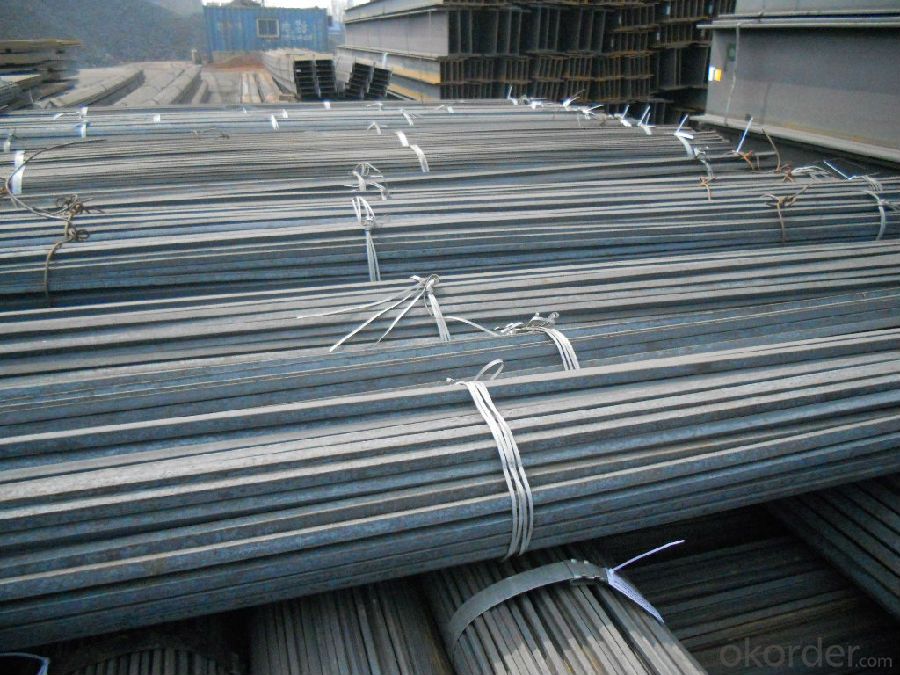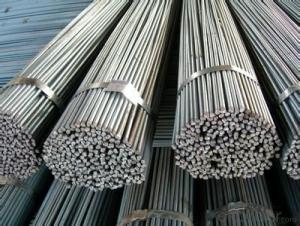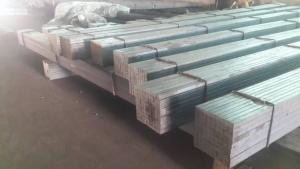Hot Rolled Square Carbon Steel Bar Material Q235
- Loading Port:
- Qingdao
- Payment Terms:
- TT or LC
- Min Order Qty:
- 25 m.t.
- Supply Capability:
- 3000 m.t./month
OKorder Service Pledge
OKorder Financial Service
You Might Also Like
Product Description:
OKorder is offering Hot Rolled Square Carbon Steel Bar at great prices with worldwide shipping. Our supplier is a world-class manufacturer of steel, with our products utilized the world over. OKorder annually supplies products to European, North American and Asian markets. We provide quotations within 24 hours of receiving an inquiry and guarantee competitive prices.
Product Applications:
The Square Steel is normally used as structure steel.
Row material for other structure steel like steel angles, channels, I-beams, H-beams, etc…
Product Advantages:
OKorder's Hot Rolled Square Steel Bar Material Q195 are durable, strong, and resist corrosion.
Main Product Features:
· Premium quality
· Prompt delivery & seaworthy packing (30 days after receiving deposit)
· Corrosion resistance
· Can be recycled and reused
· Mill test certification
· Professional Service
· Competitive pricing
Product Specifications:
Length of a side(mm) | Theoretical weight(kg/m) | Length of a side(mm) | Theoretical weight(kg/m) |
6 | 0.283 | 32 | 8.04 |
7 | 0.385 | 33 | 8.55 |
8 | 0.502 | 34 | 9.07 |
9 | 0.636 | 35 | 9.62 |
10 | 0.785 | 36 | 10.17 |
11 | 0.950 | 38 | 11.24 |
12 | 1.13 | 40 | 12.56 |
13 | 1.33 | 42 | 13.85 |
14 | 1.54 | 45 | 15.90 |
15 | 1.77 | 48 | 18.09 |
16 | 2.01 | 50 | 19.63 |
17 | 2.27 | 53 | 22.05 |
18 | 2.54 | 55 | 23.6 |
19 | 2.82 | 56 | 24.61 |
20 | 3.14 | 58 | 26.4 |
21 | 3.46 | 60 | 28.26 |
22 | 3.80 | 63 | 31.16 |
23 | 4.15 | 65 | 33.17 |
24 | 4.52 | 68 | 36.3 |
25 | 4.91 | 70 | 38.49 |
26 | 5.30 | 75 | 44.16 |
27 | 5.72 | 80 | 50.24 |
28 | 6.15 | 85 | 56.72 |
29 | 6.60 | 90 | 63.59 |
30 | 7.06 | 95 | 70.85 |
31 | 7.54 | 100 | 78.50 |
Notes:
1, The theoretical weights in the list, base on the density of 7.85 g/cm3.
2, The numbers with mean that they are not regulars or we don’t offer them.
-List 2. The allowed tolerance of Square Steel:
Length of a side(mm) | Allowed Tolerance | ||
Group1 | Group2 | Group3 | |
5.5~7 | ±0.20 | ±0.30 | ±0.40 |
7~20 | ±0.25 | ±0.35 | ±0.40 |
20~30 | ±0.30 | ±0.40 | ±0.50 |
30~50 | ±0.40 | ±0.50 | ±0.60 |
60~80 | ±0.60 | ±0.70 | ±0.80 |
80~110 | ±0.90 | ±1.0 | ±1.1 |
110~150 | ±1.2 | ±1.3 | ±1.1 |
150~190 | ―― | ―― | ±2.0 |
190~250 | ―― | ―― | ±2.5 |


FAQ:
Q1: Why buy Materials & Equipment from OKorder.com?
A1: All products offered byOKorder.com are carefully selected from China's most reliable manufacturing enterprises. Through its ISO certifications, OKorder.com adheres to the highest standards and a commitment to supply chain safety and customer satisfaction.
Q2: How do we guarantee the quality of our products?
A2: We have established an advanced quality management system which conducts strict quality tests at every step, from raw materials to the final product. At the same time, we provide extensive follow-up service assurances as required.
Q3: How soon can we receive the product after purchase?
A3: Within three days of placing an order, we will begin production. The specific shipping date is dependent upon international and government factors, but is typically 7 to 10 workdays.
Q4: What makes stainless steel stainless?
A4: Stainless steel must contain at least 10.5 % chromium. It is this element that reacts with the oxygen in the air to form a complex chrome-oxide surface layer that is invisible but strong enough to prevent further oxygen from "staining" (rusting) the surface. Higher levels of chromium and the addition of other alloying elements such as nickel and molybdenum enhance this surface layer and improve the corrosion resistance of the stainless material.
- Q:Can a steel square be used for measuring pipe diameters?
- No, a steel square cannot be used for measuring pipe diameters accurately. A steel square is primarily used for measuring right angles and checking the straightness of edges. It consists of a long steel ruler with a perpendicular arm called a tongue. While it can be helpful in some construction and woodworking tasks, it is not designed for measuring pipe diameters. To accurately measure the diameter of a pipe, one would typically use a caliper, tape measure, or a specialized tool such as a pipe diameter tape. These tools are specifically designed to measure the circumference or diameter of cylindrical objects like pipes.
- Q:Can a steel square be used for checking the squareness of cabinets?
- Yes, a steel square can be used for checking the squareness of cabinets.
- Q:Can a steel square be used for plumbing work?
- No, a steel square is not typically used for plumbing work. Plumbing tasks require specialized tools such as pipe wrenches, adjustable wrenches, and pipe cutters.
- Q:Can a steel square be used for marking out tenon shoulders?
- Yes, a steel square can be used for marking out tenon shoulders. A steel square, also known as a try square, is a tool that is commonly used in woodworking for layout and marking purposes. It has a straight edge and a 90-degree angle, which makes it ideal for marking out precise and accurate lines. When marking out tenon shoulders, the steel square can be used to ensure that the lines are perpendicular to the face and edge of the wood, which is essential for a well-fitted tenon joint. The straight edge of the steel square can be aligned with the face and edge of the wood, and then the shoulder lines can be marked along the edge of the square. This ensures that the shoulders of the tenon will be square and straight, resulting in a strong and well-fitted joint.
- Q:How do you use a steel square to measure and mark 33.75-degree angles?
- Achieving precision when working with different materials or projects can be ensured by utilizing a steel square and meticulously measuring and marking the desired 33.75-degree angle with the following steps: 1. Initiate the process by placing the steel square on a level surface, guaranteeing its proper alignment. 2. Identify the 45-degree angle on the square, typically indicated by a small notch or line. 3. Align the square in such a manner that the 45-degree angle line runs parallel to the edge of the material or surface being worked on. 4. Employ a protractor or angle measuring tool to gauge and designate a 33.75-degree angle on the steel square. 5. Once the correct angle has been determined, employ a marker or pencil to create a small mark on the steel square denoting the desired angle measurement. 6. Commencing from the mark made, employ the square as a guide to extend a straight line across the material or surface being worked on. 7. Prior to proceeding with any cutting or further work, double-check the measurements and marks to ensure accuracy. By meticulously measuring and marking the desired 33.75-degree angle using a steel square, precision can be attained when working with diverse materials or projects.
- Q:How do you use a steel square for marking stair skirt board angles?
- The process of using a steel square to mark stair skirt board angles is simple. Here is a guide on how to do it: 1. Begin by measuring the rise and run of the stairs. The rise refers to the vertical height between two stair treads, while the run is the horizontal distance between them. Take note of these measurements as they will be important for the next steps. 2. Position the steel square against the skirt board, making sure that the longer arm of the square is vertical and aligned with the edge of the board. 3. Determine the angle for the skirt board by referring to the rise and run measurements. For instance, if the rise is 7 inches and the run is 10 inches, divide the rise by the run (7/10) to obtain the decimal value of 0.7. Locate this decimal value on the rise and run tables of the steel square, which are usually found on the inner part of the square. 4. Once you have found the decimal value on the rise and run tables, locate the corresponding number on the blade of the steel square. This number represents the angle at which you should cut the skirt board. 5. Use a pencil or marking tool to make a mark on the skirt board according to the reference number on the blade of the steel square, indicating the determined angle. 6. Before proceeding with cutting or any subsequent steps, carefully check your measurements and markings to ensure accuracy. By following these steps, you can effectively utilize a steel square to mark stair skirt board angles. It is crucial to measure accurately and double-check your calculations to achieve precise and accurate results.
- Q:How can a steel square be used for making accurate cuts?
- Accurate cuts in woodworking or metalworking projects can be achieved with the use of a steel square. This precision measuring tool possesses a 90-degree angle and a straight edge, making it perfect for creating precise right angles. To make accurate cuts using a steel square, begin by marking the desired cut line on your material using a pencil or scribe. Next, position the steel square on the material, ensuring that one side of the square aligns with the marked cut line. Press the square's straight edge firmly against the material to guarantee a precise cut. Proceed by using a sharp tool, such as a saw or cutting torch for metal, to follow the edge of the steel square and cut along the marked line. The steel square acts as a reliable guide, guaranteeing a straight and accurate cut. Moreover, a steel square can also be used to verify the accuracy of existing cuts. Simply place the square against the cut edge to determine if it is perpendicular. If adjustments are required, they can be made accordingly. To summarize, a steel square is a versatile tool that facilitates accurate cuts by providing a straight edge and a 90-degree angle. This ensures precise measurements and guides the cutting tool effectively.
- Q:How do you use a steel square to determine the angle of a compound miter bevel cut?
- To use a steel square to determine the angle of a compound miter bevel cut, you will need to follow a few steps. First, place your steel square on the workpiece, ensuring that one of the arms is aligned with the edge of the material. This arm will act as the reference for measuring the angle. Next, adjust the steel square to the desired angle for the miter cut. You can accomplish this by rotating the square until the desired angle is achieved. Once the steel square is set at the desired angle, mark the angle on the workpiece using a pencil or a marking knife. This will serve as a guide when making the cut. After marking the angle, set up your compound miter saw or other cutting tool according to the marked angle. This will ensure that the cut is made accurately. Finally, carefully make the cut along the marked line, ensuring that the workpiece is securely held in place to prevent any movement or accidents. Double-check the angle of the cut to ensure accuracy before proceeding with the project.
- Q:How do you use a steel square for making right angle cuts?
- To use a steel square for making right angle cuts, you need to follow a few simple steps. First, ensure that your steel square is clean and in good condition. Then, place one edge of the square against the edge of the material you want to cut, making sure it is aligned properly. Next, hold the square firmly in place and use a pencil or marking tool to mark a straight line along the other edge of the square. This line will represent the right angle cut you want to make. Once you have marked the line, remove the square and double-check your markings to ensure they are accurate. Next, use a suitable cutting tool such as a saw or a power tool to cut along the marked line. Make sure to follow all safety precautions while using the cutting tool. Finally, after making the cut, you can use the steel square again to verify that the cut is indeed at a right angle. Place the square against the cut edge and check if it aligns perfectly with both sides of the material. By following these steps and using a steel square properly, you can ensure accurate and precise right angle cuts for your woodworking or construction projects.
- Q:What are the common applications of a steel square in woodworking?
- Woodworking relies heavily on the versatility and accuracy of a steel square, also known as a framing square or carpenter's square. Consisting of a long arm and a perpendicular arm, forming an L-shape, this tool is crucial in woodworking. Here are some common uses of a steel square in woodworking: 1. Precise layout and marking: The primary function of a steel square is to accurately lay out and mark right angles. It aids in marking perpendicular lines, square corners, and parallel lines on wood surfaces, ensuring precise cuts and joinery. 2. Squareness inspection: Woodworkers frequently employ a steel square to check if components or assemblies are square. By aligning the square against edges or corners, they can verify if the angles are 90 degrees and make necessary adjustments. 3. Measurement and squaring of boards: Steel squares have measurement scales along the long arm, allowing for precise measurement and marking of specific lengths on boards. They can also ensure the edges of boards are perfectly square by aligning the square against the edge and marking or cutting accordingly. 4. Angle determination: Steel squares often feature degree markings on the shorter arm, enabling woodworkers to measure and mark angles other than 90 degrees. This is particularly useful for projects requiring precise angles, such as mitered joints or bevels. 5. Machinery and tool setup: Steel squares are invaluable for aligning and setting up woodworking machinery and tools. They can be used to check the squareness of saw blades, fences, drill press tables, or other components, ensuring accurate and safe operation. 6. Creation of geometric shapes: By utilizing the measurement scales and angle markings, woodworkers can employ a steel square to create various geometric shapes or patterns. Triangles, hexagons, octagons, and other shapes requiring specific angles and dimensions can be easily drawn using a steel square. In summary, a steel square is an essential tool in any woodworking shop. Its ability to provide precise measurements, check for squareness, and assist in layout and marking tasks is invaluable to woodworkers of all expertise levels.
1. Manufacturer Overview |
|
|---|---|
| Location | |
| Year Established | |
| Annual Output Value | |
| Main Markets | |
| Company Certifications | |
2. Manufacturer Certificates |
|
|---|---|
| a) Certification Name | |
| Range | |
| Reference | |
| Validity Period | |
3. Manufacturer Capability |
|
|---|---|
| a)Trade Capacity | |
| Nearest Port | |
| Export Percentage | |
| No.of Employees in Trade Department | |
| Language Spoken: | |
| b)Factory Information | |
| Factory Size: | |
| No. of Production Lines | |
| Contract Manufacturing | |
| Product Price Range | |
Send your message to us
Hot Rolled Square Carbon Steel Bar Material Q235
- Loading Port:
- Qingdao
- Payment Terms:
- TT or LC
- Min Order Qty:
- 25 m.t.
- Supply Capability:
- 3000 m.t./month
OKorder Service Pledge
OKorder Financial Service
Similar products
New products
Hot products
Related keywords



























